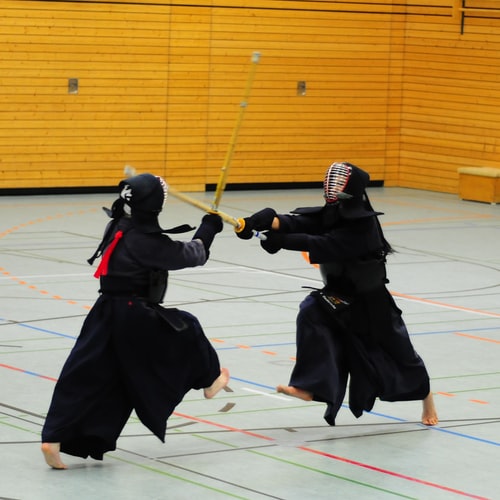Kumdo Vs. Kendo | What’s The Difference?
Kumdo Vs. Kendo | What’s The Difference?

Most people are familiar with the Japanese martial art of Kendo, but less know about a Korean martial art known as Kumdo (or Gumdo). While these arts found a home in two different nations, there does seem to be some overlap in techniques and fighting forms. So, what’s the difference between Kumdo and Kendo sword fighting? Read on here for an explanation from the experts at Swords of Northshire.
-
What is Kendo?
Kendo translates from Japanese as ‘way of the sword’ and is a modern Japanese martial art that’s descended from Kenjutsu. In Kendo, fighters use bamboo swords and protective armor in one-on-one battles. Kendo is incredibly popular in Japan, but several other countries also practice it.
Naganuma Shirōzaemon Kunisato was a famous Kenjutsu teacher who introduced the bamboo practice sword and armor. His third son, Yamada Heizaemon Mitsunori, improved upon the armor with an additional metal face grill and gauntlets. For practitioners of the art, Kendo is meant to promote self-control and discipline through the application of fighting principles with a katana.
-
What is Kumdo?

Kumdo is considered by many to be the Korean version of Kendo. In the early 1900s, Korea was subject to Japanese policies and government administration. Around 1939, when Kendo became a requirement in Japanese schools, it also became mandatory in Korean schools.
After WWII, when the Japanese left Korea, Kendo and Kumdo diverged as the Korean practitioners worked to distance themselves from the Japanese. They restructured many of the teachings to fall more in line with the Korean lifestyle and ideology.
-
Overlap
Both Kumdo and Kendo translate to mean the way of the sword in their respective languages, so it’s no surprise that both martial arts use bamboo swords as their primary weapon. Both fighting forms also utilize a face grill and thick gauntlets for protection during matches. The martial arts styles are similar enough that Korean competitors can enter Kendo competitions. Matches for both fighting styles are scored the same way, with a hit on your opponent awarding you a point. The fighter with the most points wins the match.
-
Differences

Since the divergence of Kumdo from Kendo, there are several differences that arose from Korea's need to disassociate from Japanese culture. In Kendo sword fighting, the bamboo weapon stands in for a katana, but the Korean-style sword is less curved and a little shorter.
Some other differences between the two martial arts also include the language of the terminology, minor uniform modifications, and the number of opponents you fight. Kendo is a one-on-one sparring style, but the Korean version often involves multiple opponents all fighting one person.
Derivative Fighting Styles
Because Kumdo is literally derived from Kendo, there are obviously more similarities than differences. Still, as these two countries continue to evolve separately, we might see more changes that pull them apart.
Does this blog make you curious to learn more about Japanese history and culture? Explore the Swords of Northshire blog today to learn more about ancient samurai, modern Japan, and traditional samurai weapons.
Best Sellers
- Regular Price
- from $199.99
- Sale Price
- from $199.99
- Regular Price
-
- Unit Price
- per
- Regular Price
- from $299.00
- Sale Price
- from $299.00
- Regular Price
-
- Unit Price
- per
- Regular Price
- from $199.00
- Sale Price
- from $199.00
- Regular Price
-
$0.00
- Unit Price
- per
- Regular Price
- from $619.00
- Sale Price
- from $619.00
- Regular Price
-
- Unit Price
- per
- Regular Price
- from $319.00
- Sale Price
- from $319.00
- Regular Price
-
- Unit Price
- per
- Regular Price
- from $249.00
- Sale Price
- from $249.00
- Regular Price
-
- Unit Price
- per
- Regular Price
- from $339.00
- Sale Price
- from $339.00
- Regular Price
-
- Unit Price
- per
- Regular Price
- from $219.00
- Sale Price
- from $219.00
- Regular Price
-
- Unit Price
- per
- Regular Price
- from $364.00
- Sale Price
- from $364.00
- Regular Price
-
- Unit Price
- per
- Regular Price
- from $519.00
- Sale Price
- from $519.00
- Regular Price
-
- Unit Price
- per









